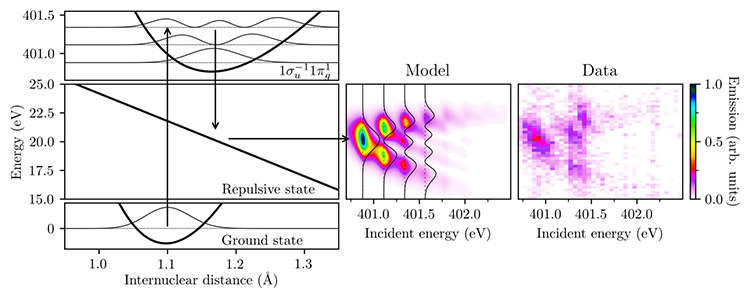For decades, scientists have referred to the measurement of the spectrum of the diatomic molecule N2 to calibrate "soft" X-rays (energy less than 2000 eV) absorption spectroscopy experiments, or to optimize a beamline implementing this technique. And, for decades, they have used approximations to describe the spectra they obtained; those approximations are applicable because of the configuration of the molecule (N-N symmetrical) and the energy of the X-rays employed. But are these approximations valid?
An international team of scientists from Sweden (University of Uppsala), Germany (Helmholtz Zentrum Berlin, EuXFEL) and France (Sorbonne University) tried to answer this question using resonant inelastic X-ray scattering (RIXS) on SEXTANTS beamline.
Their results, published in Physical Review A, prove that the absorption of an X photon by N2 can indeed be fully described in the dipole approximation.
When optimizing a soft X-ray beamline, one typically measures the absorption spectrum of N2. The transition takes a core electron to the first empty orbital, and accompanying vibrational excitations give a characteristic spectrum, which can be compared to measurements done at numerous beamlines throughout the history if synchrotron radiation.
As the N2 molecule is inversion symmetric and the dipole approximation can be applied, the transition changes the parity of the wavefunction; as the ground state is gerade, the excited state must be ungerade. Thus, the core hole in the excited state does not break the inversion symmetry, but is in a coherent superposition of localized states. This is demonstrated in the radiative decay of the core-excited state, as the same dipole selection rule applies and only gerade final states are observed.
This absorption-emission process is strictly a resonant inelastic X-ray scattering (RIXS) event, where interference between various excitation-emission pathways must be taken into account. In a recent study at the SEXTANTS beamline it was demonstrated, that while the two-step absorption-emission picture crudely describes the scattering phenomena it is essential to take lifetime-vibrational interference (LVI) into account to understand the details in the RIXS spectra. LVI is reflected in shifts of the peak positions and intensity redistribution due to the limited scattering duration.
The RIXS process also populates a new, strongly dissociative, multiply excited state in neutral N2 in the valence continua. This state is populated via so-called radiative electron rearrangement, reflecting electron correlation that is commonly described within a configuration-interaction scheme.
The final state is strongly dissociative and its potential curve has almost constant slope in the field of view. In this situation the vibrational wavefunctions of the core-excited states are directly observed in the RIXS spectra, and via the LVI effects their time-evolution on the femtosecond timescale of the scattering is monitored (Fig. 1).

Figure 1. The potential curves of the ground state, the π*-excited core hole state and the final repulsive state are shown in the left panel. In the right panel, model calculations and experimental demonstrate that the vibrational wave-function evolution is directly reflected in the RIXS spectra.
These results therefore prove that only gerade-type final states are observed, validating the application of the dipole approximation to interpret the X absorption spectra of N2.
